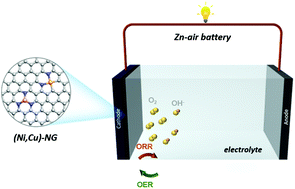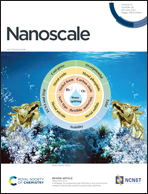Atomic Ni and Cu co-anchored 3D nanoporous graphene as an efficient oxygen reduction electrocatalyst for zinc–air batteries†
Abstract
Highly active, cost-effective and durable electrocatalysts for the oxygen reduction reaction (ORR) are critically important for renewable energy conversion and storage. Here we report a 3D bicontinuous nitrogen doped nanoporous graphene electrocatalyst co-anchoring with atomically dispersed nickel and copper atoms ((Ni,Cu)–NG) as a highly active single-atom ORR catalyst, fabricated by the combination of chemical vapor deposition and high temperature gas transportation. The resultant (Ni,Cu)–NG exhibits an exceptional ORR activity in alkaline electrolytes, comparable to the Pt-based benchmarks, from the synergistic effect of the CuNx and NiNx complexes. Endowed with high catalytic activity and outstanding durability under harsh electrochemical environments, rechargeable zinc–air batteries using (Ni,Cu)–NG as the cathodes show excellent energy efficiency (voltage gap of 0.74 V), large power density (150.6 mW cm−2 at 250 mA cm−2) and high cycling stability (>500 discharge–charge cycles at 10 mA cm−2). This study may pave an efficient avenue for designing highly durable single-atom ORR catalysts for metal–air batteries.



 Please wait while we load your content...
Please wait while we load your content...
